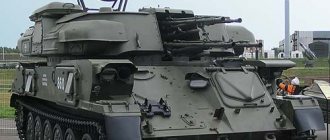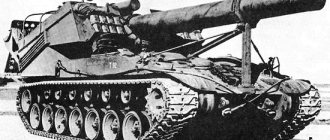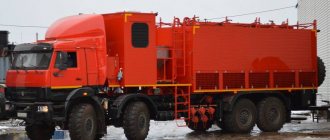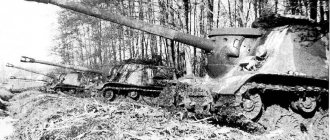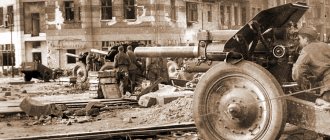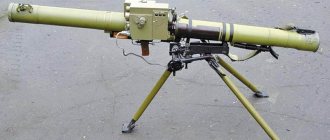Explosion against a mine: “Zmey Gorynych” as a sapper
Mine fields. A very simple and very effective means of protecting your positions from enemy attacks. Of course, they are not an absolute means of deterrence, but fighting them takes a lot of effort and time. The very first method of creating passages in minefields appeared shortly after mines and involved manually detecting and neutralizing enemy “surprises.” Effective, but long and risky. In addition, training a good sapper specialist is slow and difficult. An alternative to live sappers is metal mine trawls. But this type of mine-anti-mine equipment will become widespread only in times of widespread use of tanks. There were attempts to use artillery to clear mines, but this turned out to be even more difficult, even longer and more impractical: it was necessary to place the shells with great precision. And even then, despite the high consumption of ammunition, there were still a couple of operational mines left in the passage. The British took the first step towards modern mine clearance systems in 1912. Then a certain Captain McClintock from the Bangalore garrison proposed a revolutionary (as it would later turn out) means of combating... no, not mines - barbed wire. In those days, this defensive weapon spoiled armies no less than machine guns or other weapons. The essence of McClintock's proposal was to destroy the wire barriers by explosion. To do this, a five-meter pipe was “charged” with 27 kilograms of pyroxylin. It was proposed to slip this ammunition under the barrier and detonate it. Two or three explosions and the infantry can pass through the resulting “gate.” Due to its elongated shape, the ammunition was nicknamed the “Bangalore torpedo”. During the First World War, it was noticed that “Torpedoes” could be used not only one at a time, but also in combination - several pipes could be connected in several pieces, and for ease of movement across the battlefield, the front sections were mounted on skis or wheels. Between the world wars, an idea emerged that involved the simultaneous use of both tank trawls and Bangalore torpedoes. The tank made a passage for itself with trawls and towed a bunch of pipes with explosives. Then this “tail” was undermined, and infantry could follow the tank. The first production machine adapted for such work was the Churchill Snake, which dragged 16 five-meter pipes in succession.
Mine trawls Following the tank
In the Soviet Union, they knew about land-based “Torpedoes” and carried out the corresponding work. But before the war, the country had higher priority issues, so the engineering troops received the first such mine clearance equipment only after the war. The first Soviet extended UZ charge was a two-meter pipe with a diameter of 7 cm, which contained 5.2 kilograms of TNT. A little later, it became possible to assemble ultrasound into triangular sections of UZ-3 (three charges each), which, in turn, could be connected into a structure up to one hundred meters in length. The method of using the UZ-3 sequence remained the same - a tank with a trawl pulled out the mine clearance charges, after which they were detonated. Thanks to the triangular shape of the UZ-3 section, a passage up to six meters wide was formed in the minefield.
The UZ and UZ-3 proved to be an effective means of mine clearance, but they were not without their drawbacks.
The actual demining took place literally in the blink of an eye. But the preparation could not compare with him in speed. In addition, the tank was a good target for the enemy, not to mention the fact that the armored vehicle could be used in more “combat” ways. Then a proposal was made to make the demining charge self-propelled - a hundred-meter structure made of UZ-3 should be equipped with 45 solid fuel jet engines. As planned, the engines lifted the entire structure and dragged it into the minefield. There, having selected the brake cable, the charge exploded. The estimated flight altitude was one meter. This version of the extended charge was called UZ-3R. The idea was good, but there were significant problems in implementation. All 45 engines needed to be started simultaneously. They also had to reach maximum operating mode at the same time. The electrical circuit used could not cope with simultaneous starting. The spread in engine start time, it should be noted, was small - fractions of a second. But they were enough for the unstable movement of the entire structure. The UR-3R began to wriggle and jump from side to side, but after a few seconds it still went into horizontal flight. Flying wasn't easy either. Obstacles higher than 50-70 cm and a surface slope of even 4° were impassable for the charge. When encountering an obstacle that was too high, the demining charge literally took off into the sky and showed an aerobatics program there. As a result, for such bad temper and pyrotechnic shows, the UZ-3R received the nickname “Snake Gorynych.” Later, newer mine clearance systems will also be called this way. Under its own power
In 1968, the UR-67 armored vehicle was adopted by the Soviet engineering troops. It was a chassis of an armored personnel carrier BTR-50PK with a launcher for extended charges installed on it. A crew of three people brought the vehicle to the desired position, took aim and launched the UZ-67 charge. Unlike previous mine clearance devices, it did not have a rigid structure, but a soft one and consisted of two 83-meter-long hoses filled with explosives. One UZ-67 contained 665 kg of TNT. A solid propellant rocket (however, officially called the “DM-70 engine”), attached to the front end of the charge, is capable of delivering an explosive cord up to 300-350 meters from the vehicle. After the launch was carried out, the crew was supposed to back up to align the cord and detonate it using an electric igniter (the corresponding cable is located in the brake cable). 665 kilograms of TNT made a passage six meters wide and up to 80 meters long. The neutralization of an enemy mine during an explosion occurs due to the detonation of its fuse.
The main purpose of the UR-67 is anti-tank mines. Light anti-personnel mines either detonate or are thrown out of the passage by a blast wave, and mines with a double-tap fuse can remain operational after exposure to the UZ-67. The situation is similar with magnetic mines, although their fuse can be seriously damaged by the blast wave. As you can see, the UR-67 had enough problems, but the speed of creating a passage (2-3 minutes) and the transportable ammunition load of two charges did not leave the military indifferent. In 1972, Zmey Gorynych received a new mine clearance charge - UZP-72. It became longer (93 meters) and heavier, because it already contained 725 kilograms of PVV-7 explosive. The firing range of the UZP-72 reached 500 meters, and the maximum dimensions of the passage made increased to 90x6 meters. As before, the UZP-72 was placed by crane or manually into the appropriate compartment of the vehicle (laid in a “snake”), from where, upon launch, it was pulled out using a solid-fuel rocket coming off the guide. In 1978, the UR-67 was replaced by the UR-77 “Meteorite” installation, which is now the main vehicle of this class in the Russian army. The operating principle of the new installation remained the same, although it received new ammunition. UZP-77 is similar in characteristics to UZP-72 and differs only in some technological aspects. The basis of the extended charge “77” is the DKPR-4 detonating cables, each 10.3 meters long, connected into a single cord with cap nuts. The UR-77 is based on a lightly armored 2S1 chassis taken from the Gvozdika self-propelled howitzer.
The roots of this chassis go to the MT-LB tractor.
The launch guide for the UR-77 exhaust rockets and the cord boxes, unlike the UR-67, received protection in the form of a turret cap. A very useful innovation, because the armored ammunition boxes contain almost one and a half tons of explosives. Before launching, the armored cap, together with the launch guide, is raised to the desired elevation angle. Further, all combat work is carried out literally by a couple of buttons: one is responsible for starting the solid fuel engine, the second is for detonating the charge, and the third is for releasing the brake rope. After pressing the third button, the “Meteorite” is ready to make a new passage. It takes 30-40 minutes to recharge the unit. Laying an explosive cord can be done either as a ready-made block using a crane, or manually. The 2S1 chassis is floating (speed up to 4 km/h). It is stated that the UR-77 can launch an extended charge even from water. The tactical side of this matter looks dubious, but there is film footage of such a launch. ...and other “Snakes of Gorynychi”
A little later than UR-77, in the early 80s, engineering units received a new portable installation UR-83P. Unlike the previous Gorynychs, it did not have any chassis. The relatively compact and mobile launcher, after disassembly, can be carried by crew forces or transported on any vehicle or armored vehicle. The principle of operation of the machine installation is the same as that of its predecessors, but its smaller dimensions required the use of an extended charge consisting of only one cord. Apart from assembling the launch guide and other “related” issues, the procedure for firing a shot from the UR-83P is similar to using self-propelled guns.
The first combat use of Soviet remote mine clearance systems took place during the Yom Kippur War in 1973. These were UR-67 installations delivered to Egypt. The next mine clearing vehicle, the UR-77, managed to take part in almost all the wars in which the USSR and Russia participated, starting with Afghanistan. There is information that in some conflicts “Meteorite” was used not only for its intended purpose: several times in small settlements they played the role of artillery, laying charges on streets belonging to the enemy. You can imagine what happened at the site of the houses after the cord was blown up. Foreign countries also have similar systems in service, but, for example, the American AVLM (M58 MICLIC charges) based on a bridge layer failed to win the trust of soldiers.
No matter how much the system was improved, its reliability did not reach acceptable values.
As for the domestic UR-77, there are no plans for a replacement for it yet. The fact is that the concept of the installation turned out to be well developed already at the UR-67 stage. The Egyptian experience in using this installation only helped to finally “polish” the design and methods of application. Thus, over the thirty-odd years of its existence, the UR-77 is still not outdated and continues to be used by the domestic engineering forces. UR-77 in action
Source
Category: Military equipment
© 2012 FUN-SPACE.ru. All rights reserved.
Original nickname
Nicknames of heroes of folk epics are extremely rare even in our troops, which are generous with nicknames and sobriquets.
During the first experiments with self-propelled mine clearance systems, the UZ-3R vehicle entered service with the Soviet army, which was the same “Bangalore torpedo”, only built by us and equipped with 45 jet engines. However, due to errors in the electronics, the engines started with a difference that was minimal but curious enough.
Such malfunctions caused an amusing spectacle - the charge was thrown in the air, and flames burst out of the thruster nozzles. Such a flight seemed similar to the fire-breathing flying villain from Russian folklore - “The Serpent Gorynych”, which gave this nickname to all subsequent mine clearance installations that were built on the main idea of this device.
Super snake
However, the Soviet army did not stop there. Using clamps, three US charges were connected into a triangular section US-3. From such sections it was possible to assemble a demining charge (8 kg of TNT per linear meter) up to 100 meters long. The explosion of an extended charge delivered to the minefield by a tank with a trawl caused the mines to go off in a strip six meters wide.
The UZ-3 charge became the hobby of the generals of the engineering troops. The explosion of such a quantity of explosives spread over 100 meters was extremely spectacular for the military leaders present at the exercises - both ours and foreign ones. Finally, the sappers had the opportunity to clearly and effectively show their work: it looked no less beautiful than the bomb “path.”
However, Marshal of the Engineering Troops Kharchenko soon came to the conclusion that all existing methods of making passages in minefields did not meet the requirements of tankers. Passages in enemy minefields must appear suddenly and instantly. The instantaneous charge of the UZ-3 is ensured. But suddenness is a bad thing. A lone tank, slowly crawling across the field and pulling a mine clearance charge behind it, clearly cannot provide it.
New technologies
When rocket powder engines were placed between the sections, they lifted the entire structure up and pulled it forward. Effective and instant.
It looked like this. An UZ-3R was delivered to the front line in the Urals, after which sappers assembled a truss up to 100 meters long from pipes. It was installed at a position 300 meters from the nearest minefield border. When artillery destroys enemy positions, the UZ-3R receives an order to launch a shell - and all 45 jet engines turn on simultaneously. The unit flies at a height of up to 1 meter, runs into the enemy’s brake cable and falls. An explosion - and a 6-meter wide passage for tanks and infantry is ready.
The main thing is setting
View gallery
Powerful and modern “Serpent Gorynych” weapon. The operating principle of the entire mine clearance system is as follows:
- The UR-77 makes a passage and moves towards the minefield, while it can stand at a distance of 200-500 m.
- The distance to the border of the minefield is determined by the commander, who raises the turret installation to a certain elevation angle, after which he gives the command to launch the charge.
- The missile emerges from a guide and flies along a certain trajectory, while pulling behind it a flexible cable connected to an explosive.
- The rocket with the charge moves away to a length determined by the length of the brake rope - it is attached to the nose of the vehicle.
- The charge falls on the minefield, and the rocket propellant motor is cut off.
- The driver moves the car backwards to level the charge into a straight line.
- The brake rope comes off.
- The time for a full cycle of making a passage takes a maximum of 5 minutes
- After the first cycle is completed, the second charge is started.
- Recharging the car takes about 40 minutes.
To carry out this procedure, the machine moves to a predetermined location. Reloading time by a crew with an attached sapper squad is 30-40 minutes.
Combined arms demining kits OVR-1 and OVR-2
| 1 — device for non-detonation destruction of UBRM mines |
| 2 — extended mine clearing charge |
| 3 — KRAG throwing device |
| 4 - special cat |
| 5 — K8-S helmet, FZS sapper frontal protection, sapper probe |
Designed for continuous mine clearing and making passages in minefields. The kits allow you to:
- conduct preliminary reconnaissance of the area;
- make passages in minefields of anti-tank and anti-personnel mines using special and universal cats, extended mine clearance charges, delivered using a throwing device at a distance of up to 50 m;
- destroy mines and other explosive objects installed in the ground and on the surface of the ground;
- carry out reconnaissance in buildings using an extension rod, an IMP-2 mine detector and an antimagnetic probe;
- mark the boundaries of minefields and explosive ordnance sites using anti-magnetic flags and warning signs.
The OVR-1 set is intended for combined arms units and contains the equipment necessary for conducting mine-search operations, including:
- KRAG throwing device;
- sapper cat 019B;
- sapper probe IYAUSH;
- warning signs, flags, tapes.
The OVR-2 set is intended for units of the engineering troops; it differs from the OVR-1 set in additional equipment, including the presence of special means for neutralizing explosive devices:
- device for non-detonation destruction of mines UBRM;
- KRAG throwing device;
- extended mine clearance charge UZR-1Sh;
- device KVP-4/100
How does it work?
The UR-77 is a lightly armored self-propelled mine clearing unit that can make 6 m wide passages in minefields that are crammed with anti-tank anti-track mines and mines with pin target sensors. Experts note that the system easily and reliably copes with detonating high-explosive anti-personnel mines (similar to the American M14) in a strip up to 14 m wide.
View gallery
One of the most reliable means of mine clearance today is the “Serpent Gorynych” system (weapon). How to use it? Mines explode due to the fact that their own fuses are triggered by the shock wave. It, in turn, is formed during the explosion of an extended mine clearance charge. The installation itself includes two elements - the base vehicle in the form of a modified chassis and the turret installation, consisting of launch guides for two missiles and two compartments for sections of the detonating cable.
The first demining installations
UR-67
Testing of explosive destruction of both infantry and tank barriers began in the early 20th century. The British military engineer McClintock constructed a means of overcoming barbed wire barriers from a metal pipe and an explosive charge: an extended charge (EL) was placed under the barrier and detonated. The gun was named after the Indian city where the inventor served - “Bangalore Torpedo”.
During operation, the torpedo underwent many modifications: the charges were connected to each other for greater explosive power, fastening mechanisms were changed, and wheels and skis were attached to the torpedo for mobility. During the Great Patriotic War, the torpedo became part of the armament of both the Allied army and the Wehrmacht.
Three-headed snake in service with the USSR
Mine clearance installation UR-67
In the USSR, the industrial production of ultrasonics was established already in the post-war period. Increasing the defense power, the production of the Soviet version of the torpedo was launched - a tube 1.95 m long stuffed with 5 kg. TNT. To increase the effectiveness of the invention, it was decided to connect three charges together; the triangular UZ-3 cleared a 6 m wide strip of mines with one explosion. Such a corridor was enough for the passage of a tank column.
The disadvantage of the design was the method of transporting it to the explosion site. It could only be delivered by a tank with a trawl, which entailed the risk of declassifying the location of the military forces.
Expert opinion Expert Daniil Rodionov
historian, USSR State Prize laureate, Doctor of Historical Sciences
A solution was quickly found, the design underwent another modernization: powder-powered engines were attached to the charge sections. By reactive reaction, the structure rose 1 m upward and could move deep into the minefield at a distance of up to two hundred meters.
One Ural truck could transport the charge. For its entertainment and mode of movement, the UZ-3 was dubbed “Snake Gorynych.” For effective mobility of Gorynych, traction was provided by 45 engines, the ignition of which had to be carried out synchronously. It was difficult to achieve consistent ignition under the technical conditions of that time. A gap at the beginning of engine combustion lasted a fraction of a second, and the UZ-3 changed its flight path, fell apart into sections, and lost part of its power.
Mine clearance installation UR-77 MeteoriteUR-67
“Zmey Gorynych” is a weapon based on the UR-67. This mine clearance system was used to combat anti-tank mines. True, the first version was not the most advanced, and the UR-67 was replaced by the UR-77 “Meteorite,” which is still considered the main vehicle of this type in the Russian army. While maintaining the main design features of the system and its operating principle, it began to be equipped with new ammunition. The extended charge 77 is based on detonating cables more than 10 m long, which are connected into a single cord with cap nuts.
How the design has changed...
It is noteworthy that when creating the model, the designers proposed abandoning the basic tracked vehicle. This type of mine clearance system was designated UR-83P; it was transported on a truck, after which it was assembled directly on the battlefield, in a tank trench.
The tank installation had a lightweight frame, but the system was not widespread because it was much weaker in terms of efficiency. In wartime, the “Serpent Gorynych” (a weapon that is still considered one of the most reliable in the world) was an excellent assistant in overcoming minefields. At least there was an opportunity to save the lives of sappers and miners.
Based on the Gvozdika howitzer
“Zmey Gorynych” is a mine clearance weapon that, thanks to its unique characteristics, has remained popular for decades. The equipment used is the 2S1 “Gvozdika” self-propelled howitzer, which has a classic turret design. Its body is created on the basis of steel sheets, is characterized by tightness and the ability to overcome water obstacles. The building has three sections: power, control and combat.
View gallery
On the roof there is a welded turret, the fighting compartment of which is equipped with a rotating basket. The turret is equipped with a gun and space for the crew. On the starboard side there is a loader's seat, stowage for cartridges, and on the left side there is a gunner's seat and sighting devices. The main weapon is a howitzer, which uses 122 mm ammunition. The howitzer operates using high-explosive fragmentation shells of various types, which are often supplemented with contact fuses. The maximum firing range is 15.2 km.
Features of the updated system
It is planned that the UR-07M model, which will replace the Zmey Gorynych installation, will easily cope with mine clearance of the coastal strip. With its help, it will be possible to make passages of sufficient width in the coastal line of the sea at a depth of up to five meters. The passages will be made gradually - by launching groups of ammunition from a carrier moving along the shore, after which they will be detonated at the passage target. It is noted that the ship's pitching will not affect the accuracy of the supply of ammunition, since this will be compensated by automatic fire control based on a computer. The designers emphasize that the “Snake Gorynych”, as a mine clearance weapon, still requires a re-evaluation of both design and technical parameters in order to meet modern requirements. That is why it was decided to improve the old system by introducing modern technologies into it.
View gallery
As an addition to the system, there is a URP-01 Garter trailer, which allows you to make passages in anti-tank minefields. The charges are launched both from towing equipment, without requiring the crew to exit the vehicle, and autonomously - on the ground or from a trench.
What are the prospects?
“Serpent Gorynych” (UR-77 weapon), which was also called “Meteorite” in the war, was again transferred to the Russian Federation in 2014, albeit in a new form. The updated installation was developed by the Balashikha Research Institute and designers. The base was used as the chassis for this model. The launcher is additionally equipped with extended mine clearance charges.
“Snake Gorynych” is a weapon in Russia that is popular due to its thoughtful design and technical characteristics. With their help, you can make passages in a minefield several tens of meters wide at any distance. The updated charges are capable of destroying any types of mines. The charge of this installation is a rocket to which a long cable is attached: explosives are located on it. When the cable falls to the ground, the explosive detonates and detonates mines within a radius of several meters. This creates a safe passage through which infantry can pass and military equipment can pass.
As noted by the experts who tested this system, the mine clearance charges detonate some of the mines. And devices that are protected from explosion are thrown outside the cleared passage. In any case, in combat conditions this installation will be more effective.
